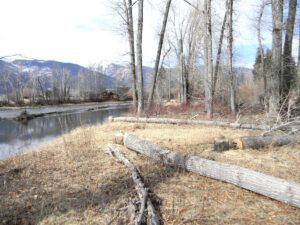By Michael Howell
It’s not only the river that is eating away at the banks of the river on the south end of the Lee Metcalf National Wildlife Refuge, there are also some beavers eating away at the large cottonwood trees that help stabilize the river bank.
Refuge officials recognized the problem earlier this year and wrapped wire fencing around a handful of trees in the area to protect them. Those efforts were successful in saving the trees that were under attack at the time. But the voracious creatures were unrelenting and simply moved on to the next trees in line down the bank. Their subsequent forays have taken down at least ten large cottonwoods on the bank and they are hard at work on nine others.
Wrapping wire guards around every tree along the river bank may not be the most practical form of deterrence. Information officer at the Refuge, Bob Danley, said that the situation would be evaluated and it may require hiring a trapper to come in and remove the animals.
It’s not just wildlife refuges that are occasionally plagued by hungry beavers. Last year the City of Hamilton had six beavers live trapped and removed from Hieronymus Park where the critters were clogging up the pond drain and causing it to overflow into an undesired area.

MJ Graham says
Seriously unscientific findings. This is what beaver do and in doing so create wetland habitats that are among the most diverse and productive ecosystems on the planet. Without these rodents, aquatic flora and fauna face serious survival issues, which became quite evident during the 1800s in North America. Over time, beavers will abandon the area once food sources are depleted and the system will evolve through natural succession to a meadow and eventual forests with the stream sometimes returning to its original state. If this is a wildlife refuge, then leave it to the whims of nature to do what only nature manages best. “If one wants to have any idea of what the world once looked like, one must remember that it was inhabited by beavers.” Lars Wilson